Rhenish German Coldblood
The Rhenish German Coldblood, German: Rheinisch Deutsches Kaltblut, is a breed of heavy draught horse from the Rhineland area of western Germany. It was bred in second part of the nineteenth century, principally at the Prussian state stud at Schloss Wickrath in Wickrathberg, now part of Mönchengladbach in North Rhine-Westphalia.[7]
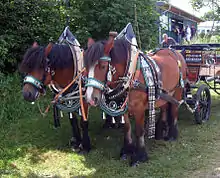 | |
| Other names | |
|---|---|
| Country of origin | Germany |
| Traits | |
| Distinguishing features | Male height: over 159 cm Female height: 149–159 cm[4] |
| Notes | |
| Conservation status: FAO (2007): endangered[5] GEH: Category III, endangered[6] | |
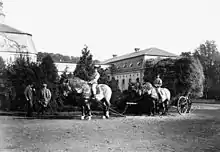
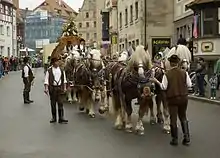
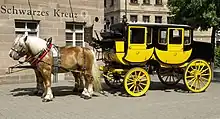
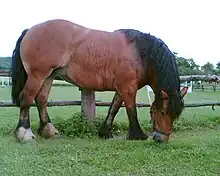
History
The farmers of the Rhineland needed powerful horses to work the heavy loess soil of the area. In the nineteenth century various heavy horses were imported from neighbouring countries – Belgium, Denmark, France and the Netherlands – as were Clydesdale, Shire and Suffolk Punch animals from England; these led to little improvement of the local stock, partly because of acclimatisation problems, partly because of lack of a clear direction.[7] In the 1870s the decision was taken at the Prussian state stud at Schloss Wickrath, at that time in the Rhine Province of the Kingdom of Prussia, to concentrate breeding on the Belgian type.[8]: 17 The first Belgian stallions stood at Wickrath in 1876, and by 1880 there were fifty. A stud book was opened in 1892; there were 148 mares registered in that year. Numbers of the breed grew rapidly in the first half of the twentieth century, and by 1946 there were 26,990 registered mares. In some years 700 young stallions were presented for approval for breeding.[7]
The Second World War caused a drastic decline in the Rhenish German Coldblood. While there was a brief revival in agricultural use of horses in the post-War years, the progressive mechanisation of agriculture led to a further decline. The Wickrath stud was closed in 1957, and merged into the stud of Warendorf, in Westphalia. By 1975 there were eleven mares and two stallions registered in the stud book.[7] Numbers have slowly recovered, and in 2013 were reported as 1173 mares and 149 stallions.[4]
The Rhenish German Coldblood was listed as "endangered" by the FAO in 2007;[5] it is listed in Category III, "endangered" on the red list of the Gesellschaft zur Erhaltung alter und gefährdeter Haustierrassen.[6]
Because of the political division of Germany in the aftermath of the Second World War, which lasted until the Fall of the Berlin Wall in 1989, there was for more than fifty years no possibility of interbreeding between populations of the Rhenish German Coldblood in West Germany and those in the East. Three regional sub-populations of the breed developed in East Germany during this time: the Altmärkisches Kaltblut in the historical Altmark region, the Mecklenburger Kaltblut in the historical Mecklenburg region, and the Sächsisch-Thüringisches Kaltblut in Thuringia and the former province of Saxony. As a result of their long reproductive isolation, the Mecklenburger and Sächsisch-Thüringische sub-populations, while genetically indistinguishable, are genetically distinct from the Rhenish German Coldblood of the western part of the country.[3]
References
- Breed data sheet: Rheinisch Deutsches Kaltblut/Germany. Domestic Animal Diversity Information System of the Food and Agriculture Organization of the United Nations. Accessed October 2014.
- Bonnie Hendricks (2007). International encyclopedia of horse breeds. Norman: University of Oklahoma Press. ISBN 9780806138848. p. 207–208.
- K.S. Aberle, H. Hamann, C. Drögemüller, O. Distl (2004). Genetic diversity in German draught horse breeds compared with a group of primitive, riding and wild horses by means of microsatellite DNA markers. Animal Genetics 35 (4): 270–277. doi:10.1111/j.1365-2052.2004.01166.x
- Rassebeschreibung Pferd: Rheinisch Deutsches Kaltblut (in German). Zentrale Dokumentation Tiergenetischer Ressourcen in Deutschland (TGRDEU). Accessed October 2014.
- Barbara Rischkowsky, D. Pilling (eds.) (2007). List of breeds documented in the Global Databank for Animal Genetic Resources, annex to The State of the World's Animal Genetic Resources for Food and Agriculture. Rome: Food and Agriculture Organization of the United Nations. ISBN 9789251057629. Accessed October 2014.
- Rheinisch-Deutsches Kaltblut (in German). Gesellschaft zur Erhaltung alter und gefährdeter Haustierrassen (GEH). Accessed January 2017.
- Mathias Vogt (1995). Rheinisch-Deutsches Kaltblut - Ein erhaltenswertes Kulturgut (in German). Gesellschaft zur Erhaltung alter und gefährdeter Haustierrassen (GEH). Accessed October 2014.
- Annette Harbers (2004). Quellen und Materialien zur Geschichte des Rheinischen Landgestüts Wickrath (1839-1957) (in German). Doctoral dissertation, Tierärztlichen Hochschule Hannover. Accessed October 2014.